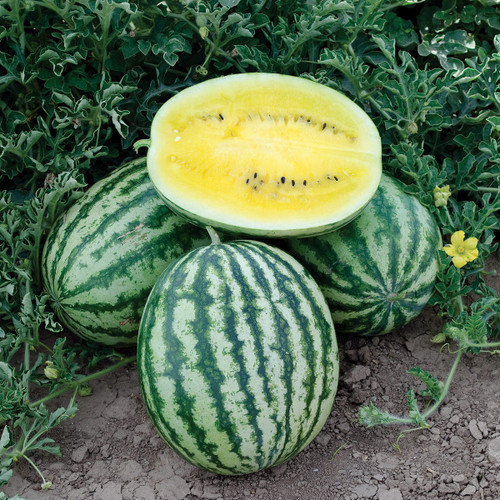Seeded Watermelon (Citrullus lanatus)
Watermelon is a warm-season crop in the cucurbit family, related to cantaloupe, squash, cucumber, and pumpkin. Seeded watermelons include both open-pollinated and F1 hybrid varieties, with a wide range of rind patterns and flesh colors.
Temperature
Seed germination occurs between 68°–95°F. Optimum is around 77°F with emergence in 5 days. Germination below 70°F is slow and may cause uneven stands. Avoid planting too early. Multiple staggered plantings improve harvest consistency and reduce crop loss risk.
Soil
Well-drained sandy loam soils are preferred, especially those not recently used for cucurbits. Raised beds help early-season drainage and warming. Avoid compaction and water stress to promote healthy root growth. Soils must be kept moist during the first two weeks after emergence.
Planting
Seeds should be planted 1" deep. Use 1–2 lbs seed per acre, depending on spacing and seed size. Transplanting improves uniformity and allows earlier harvest. Transplants should be placed slightly deeper in the soil than in the greenhouse and watered well at planting to eliminate air pockets and support root establishment. Fully bury peat pots to avoid moisture wicking.
Spacing
24–48" in row and 72" between rows
Harvest
Watermelons are mature when sugar content reaches 10%+, rind shows a yellow belly spot, and nearby tendrils turn brown. Thumping yields a soft, hollow sound. Flesh color ranges from deep red to yellow. Avoid harvesting too early—sugar content does not increase after harvest. Use clippers to cut fruit from vine and turn them bottom-side down to prevent sunscald. Consume within 2–3 weeks for best texture and flavor. Use a refractometer for precise sweetness readings. Rind indicators and ribbed indentations help confirm ripeness in certain types like Charleston Gray.
For more information, please see links below:
- Penn State - Watermelon Production
- University of Georgia - Watermelon Guide
- University of Kentucky - Watermelon
Note: This information is summarized. Additional details and expanded guidelines can be found in our production sheets available in the Holmes Seed Grower's Guidebook.
Downloadable Copy:


